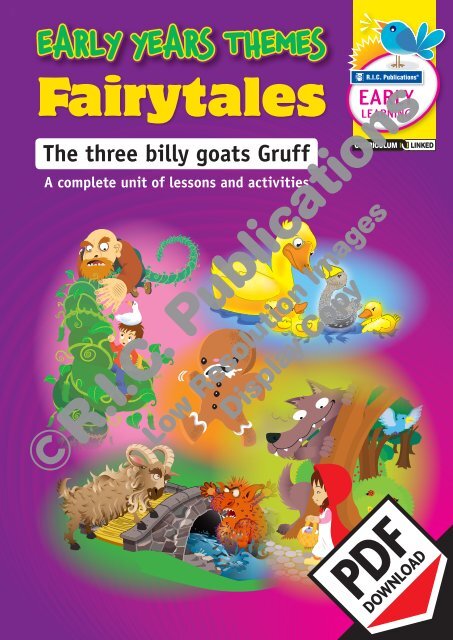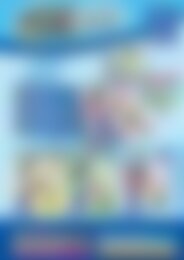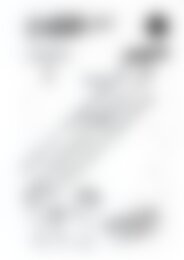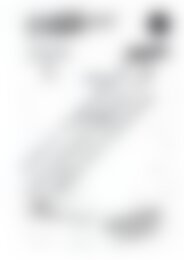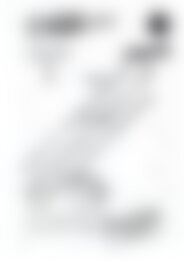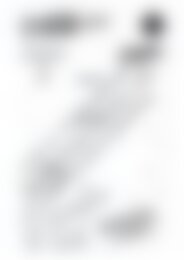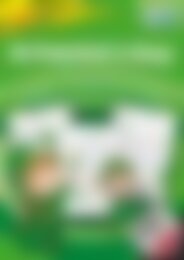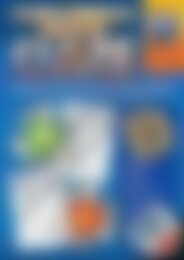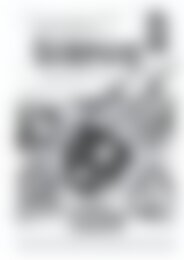RIC-20935 Early years Fairytales - Billy goats
Create successful ePaper yourself
Turn your PDF publications into a flip-book with our unique Google optimized e-Paper software.
EARLY YEARS THEMES<br />
<strong>Fairytales</strong><br />
The three billy <strong>goats</strong> Gruff<br />
A complete unit of lessons and activities
<strong>Early</strong> <strong>years</strong> themes—<strong>Fairytales</strong><br />
Published by R.I.C. Publications ® 2011<br />
Copyright © R.I.C. Publications ® 2011<br />
<strong>RIC</strong>– <strong>20935</strong><br />
Titles in this series:<br />
<strong>Early</strong> <strong>years</strong> themes—Places<br />
<strong>Early</strong> <strong>years</strong> themes—People<br />
<strong>Early</strong> <strong>years</strong> themes—Animals<br />
<strong>Early</strong> <strong>years</strong> themes—Science<br />
<strong>Early</strong> <strong>years</strong> themes—Fantasy<br />
<strong>Early</strong> <strong>years</strong> themes—<strong>Fairytales</strong><br />
<strong>Early</strong> <strong>years</strong> themes—Special days and celebrations<br />
Copyright Information<br />
Only the blackline masters contained within this<br />
publication may only be reproduced by the original<br />
purchaser for use with their class(es). The publisher<br />
prohibits the loaning or onselling of these blackline<br />
masters for purposes of reproduction. No other part<br />
of this publication may be reproduced in any form or<br />
by any means, electronic or mechanical, including<br />
photocopying or recording, or by any information<br />
storage and retrieval system, without written<br />
permission from the publisher.<br />
Accompanying resources available:<br />
<strong>Early</strong> <strong>years</strong> themes—<strong>Fairytales</strong> Posters (set of 5)<br />
<strong>Early</strong> <strong>years</strong> themes—<strong>Fairytales</strong> Stickers (set of 5)<br />
<strong>Early</strong> <strong>years</strong> themes Interactive CD (Places, People,<br />
Animals, Science)<br />
<strong>Early</strong> <strong>years</strong> themes Interactive CD (Fantasy, <strong>Fairytales</strong>,<br />
Special days and celebrations)<br />
Internet websites<br />
In some cases, websites or specific URLs may be recommended. While these are checked and rechecked at the time of publication,<br />
the publisher has no control over any subsequent changes which may be made to webpages. It is strongly recommended that the class<br />
teacher checks all URLs before allowing students to access them.<br />
View all pages online<br />
PO Box 332 Greenwood Western Australia 6924<br />
Website: www.ricpublications.com.au<br />
Email: mail@ricgroup.com.au
Teachers notes<br />
The format of this series of books<br />
This series of books is designed to cater for early childhood teachers who use learning centres and cross-curricular activities as<br />
a basis for planning activities to develop key concepts and skills. Teachers will easily be able to locate activity-based learning<br />
within this complete compilation of ideas.<br />
All of the five themes within each book follow the same format over 20 pages. Each theme consists of:<br />
1. A title or cover page with<br />
appropriate artwork which the<br />
teacher can utilise for themebased<br />
activities.<br />
2. A number of pages of cross-curricular learning activities to develop the<br />
theme. Those themes which relate closely to a specific learning area may<br />
have more activities in key learning areas such as science. All themes<br />
have activities which are predominantly ‘hands-on’.<br />
3. Background information with useful facts about the theme.<br />
4. A list of concepts to be developed provides suggested developmentallyappropriate<br />
learning outcomes to be achieved by completing the theme.<br />
iv <strong>Early</strong> <strong>years</strong> themes—<strong>Fairytales</strong> www.ricpublications.com.au – R.I.C. Publications ®<br />
ISBN 978-1-74126-971-0
Teachers notes<br />
The format of this series of books<br />
5. A small number of resource/blackline pages which can be used<br />
to create games or oral language activities, as templates for art<br />
and craft activities or as worksheets for more capable children who<br />
are beginning to read and understand mathematical concepts.<br />
6. Recipes relating to the theme—<br />
simple cooking and non-cooking<br />
recipes, including those for<br />
manipulative play, such as ‘goop’.<br />
7. Display ideas for art and craft or<br />
specific learning centres.<br />
8. A list of literature resources to<br />
complement the theme, including<br />
songs, action rhymes and fiction<br />
and nonfiction books.<br />
9. A notes section to enable the teacher<br />
to record useful websites or resources<br />
relating to the theme, or other<br />
worthwhile activities or ideas etc.<br />
R.I.C. Publications ® – www.ricpublications.com.au <strong>Early</strong> <strong>years</strong> themes—<strong>Fairytales</strong> v<br />
ISBN 978-1-74126-971-0
Teachers notes<br />
An explanation of the icons<br />
A number of icons have been used throughout the cross-curricular activities sections to make it easier and quicker for teachers to<br />
locate appropriate learning activities.<br />
Fine motor activities—building with blocks, puzzles, sorting, sand and water play, sensory items<br />
such as ‘feely boxes’, playdough or clay work, threading, chalkboards, construction using recycled<br />
materials such as boxes<br />
Outdoor play—sand and/or water play (see also ‘fine motor activities’); gross motor activities such as<br />
climbing, balancing, bikes, scooters, jumping, throwing, obstacle course activities etc.; tracking activities<br />
using balloons and bubbles etc.; other messy art activities<br />
Dramatic play—home corner, dramatising stories, dressing up, puppets, shopping etc.<br />
Art and craft—free painting, directed and supervised painting,<br />
craft (assisted and independent)<br />
Computer—suggestions for simple games or activities<br />
(usually individual or pairs) or relevant internet activities<br />
Cooking—supervised activities, some of which use heat<br />
Games—indoor or outdoor games relating to literacy such as card<br />
games, memory games etc.; mathematics, singing games, any<br />
physical education games involving movement etc.<br />
Writing—tracing, copying, writing on, and with, different things—cards, different types of paper etc.;<br />
adding patterns or stripes etc.; tracking and following paths, dot-to-dot activities etc.<br />
vi <strong>Early</strong> <strong>years</strong> themes—<strong>Fairytales</strong> www.ricpublications.com.au – R.I.C. Publications ®<br />
ISBN 978-1-74126-971-0
Teachers notes<br />
About the artwork<br />
All the artwork in this series of books is:<br />
• age-appropriate<br />
• teacher- and child-friendly<br />
• an additional resource to help develop the theme<br />
• suitable for enlarging for:<br />
~ colouring<br />
~ handwriting<br />
~ dot-to-dot sheets<br />
~ use as templates for art and craft activities<br />
~ visual texts to encourage oral language development.<br />
Some artworks are based on simple shapes to support learning in the mathematics<br />
area; others are more elaborate. It is anticipated that early childhood teachers will<br />
view an illustration based on shapes and be able to use this idea to develop concrete<br />
play activities using shapes or as a technology and design project. More elaborate<br />
artwork is used to demonstrate a teaching resource which needs to be made, a recipe,<br />
game or other activity.<br />
Examples of artwork relating to art and craft activities have wide, bold, easily visible<br />
cutting outlines to allow the children some variation in the cutting path they will use.<br />
About the resource sheets/blacklines<br />
Resource sheets/blacklines contain:<br />
• simple, age-appropriate artwork<br />
• prominent visual clues<br />
• little or no text<br />
• visual clues to support text pages<br />
• few instructions, so as not to confuse beginning readers<br />
• teacher instructions in the margins with a number of different<br />
suggestions for using the resource sheet/blackline<br />
• literacy and numeracy activities.<br />
These resource sheets/blacklines are included as valuable time-savers<br />
for teachers.<br />
It is anticipated that the teacher will enlarge any pages to A3 size and<br />
photocopy them onto more durable paper or card, to make them easier<br />
for learners of this age group to manipulate.<br />
The cross-curricular section of each theme includes a reference to<br />
resource sheets/blacklines relating to specific activities.<br />
R.I.C. Publications ® – www.ricpublications.com.au <strong>Early</strong> <strong>years</strong> themes—<strong>Fairytales</strong> vii<br />
ISBN 978-1-74126-971-0
Teachers notes<br />
Curriculum links<br />
All the learning activities in this series of books support the key learning areas of the current curriculum documents.<br />
In particular, one or more activities also support each strand of the new English and Mathematics National Curriculum. The<br />
specific strands from the National Curriculum relating to each activity are denoted by the words in brackets in the English and<br />
Mathematics learning areas of the cross-curricular section.<br />
For example, in the ‘The three billy <strong>goats</strong> Gruff’ theme:<br />
English Talk about the use of capital letters for the beginning of special names such as ‘Gruff’. Create a goat from<br />
a large capital ‘G’. Use cardboard, paper, crayons and googly eyes. Alternatively, cover a lower-case ‘g’<br />
with Easter grass. (Language)<br />
Mathematics<br />
Reference to both is shown below.<br />
Provide coloured pattern blocks or coloured paper shapes for the children to create goat shapes from.<br />
(Measurement and Geometry)<br />
Relevant curriculum reference<br />
NSW<br />
Qld<br />
SA<br />
Vic.<br />
WA<br />
National Curriculum: refer to pages 6 and 11 of Shape of the Australian Curriculum: English<br />
National Curriculum: refer to pages 6 and 7 of Shape of the Australian Curriculum: Mathematics<br />
National Curriculum: Science learning activities also support pages 6 and 7 of Shape of the Australian<br />
Curriculum: Science<br />
Belonging, being and becoming: The early <strong>years</strong> framework for Australia (2009)<br />
Refer to <strong>Early</strong> <strong>years</strong> curriculum guidelines page 55 (Table 9: A<br />
summary of the learning statements in the early learning areas)<br />
and pages 61–75.<br />
Refer to ‘<strong>Early</strong> <strong>years</strong> band: Age 3–Age 5’. South Australian<br />
Curriculum, Standards and Accountability at .<br />
Refer to Victorian essential learning standards Level 1 at<br />
.<br />
Refer to K-3 scope-and-sequence charts at .<br />
viii <strong>Early</strong> <strong>years</strong> themes—<strong>Fairytales</strong> www.ricpublications.com.au – R.I.C. Publications ®<br />
ISBN 978-1-74126-971-0
Teachers notes<br />
Sample social skills checklist<br />
Date:<br />
Student name<br />
separates easily from<br />
parents<br />
interacts readily with<br />
adults<br />
interacts readily with<br />
peers<br />
shares with others and<br />
takes turns<br />
participates in group<br />
activities<br />
cooperates with others<br />
accepts responsibility<br />
for own behaviour<br />
respects the property<br />
of others<br />
respects the feelings of<br />
others<br />
listens without<br />
interrupting<br />
expresses feelings<br />
appropriately<br />
solves simple problems<br />
is developing an<br />
awareness of the wider<br />
community<br />
R.I.C. Publications ® – www.ricpublications.com.au <strong>Early</strong> <strong>years</strong> themes—<strong>Fairytales</strong> ix<br />
ISBN 978-1-74126-971-0
Teachers notes<br />
Sample language skills checklist<br />
Date:<br />
Student name<br />
communicates needs clearly<br />
articulates most words correctly<br />
relates personal experiences<br />
contributes to discussions<br />
uses age-appropriate<br />
vocabulary<br />
articulates most initial sounds<br />
correctly<br />
asks appropriate questions<br />
speaks in complete sentences<br />
relates events in order of<br />
occurrence<br />
able to tell a story from pictures<br />
retells a familiar story without<br />
pictures or clues<br />
uses simple compound<br />
sentences<br />
responds appropriately to<br />
questions about himself/herself<br />
listens to a story for a given<br />
length of time<br />
follows simple two-step<br />
instructions<br />
knows his/her first and last<br />
names<br />
recognises rhyming words<br />
answers simple oral cloze<br />
questions<br />
labels emotions such as happy,<br />
sad, angry, scared …<br />
x <strong>Early</strong> <strong>years</strong> themes—<strong>Fairytales</strong> www.ricpublications.com.au – R.I.C. Publications ®<br />
ISBN 978-1-74126-971-0
Teachers notes<br />
Sample fine motor skills checklist<br />
Date:<br />
Student name<br />
completes simple puzzles<br />
builds a tower of eight or more<br />
small blocks<br />
dresses himself/herself (apart<br />
from buttons and shoelaces)<br />
manipulates playdough to<br />
create a specific object<br />
places small pegs in small<br />
holes<br />
threads small beads<br />
uses scissors to cut out simple<br />
shapes and pictures<br />
completes simple folding<br />
activities<br />
uses a knife, fork and spoon<br />
correctly<br />
holds a crayon or pencil<br />
correctly<br />
colours within lines<br />
writes or copies own name<br />
draws and copies simple<br />
pictures<br />
copies a sequence of letters or<br />
numbers adequately<br />
traces or recreates patterns<br />
R.I.C. Publications ® – www.ricpublications.com.au <strong>Early</strong> <strong>years</strong> themes—<strong>Fairytales</strong> xi<br />
ISBN 978-1-74126-971-0
Teachers notes<br />
Sample fundamental movement skills checklist<br />
Date:<br />
Explicit teaching<br />
Exposure<br />
Student name<br />
balances on one<br />
foot (static balance)<br />
runs<br />
jumps vertically<br />
catches a ball or<br />
beanbag<br />
hops<br />
throws a ball or<br />
beanbag using an<br />
overarm movement<br />
gallops sideways<br />
skips<br />
leaps<br />
kicks a ball<br />
strikes a ball or<br />
object using a twohanded<br />
strike<br />
dodges a ball or<br />
object<br />
xii <strong>Early</strong> <strong>years</strong> themes—<strong>Fairytales</strong> www.ricpublications.com.au – R.I.C. Publications ®<br />
ISBN 978-1-74126-971-0
Teachers notes<br />
Sample mathematics skills checklist<br />
Date:<br />
Number and algebra Measurement and geometry Statistics and probability<br />
Student name<br />
recognises numerals 1 to<br />
writes numerals 1 to<br />
rote counts to<br />
places numerals to<br />
in correct order<br />
understands one-to-one<br />
correspondence<br />
understands ‘more than’ and ‘less<br />
than’<br />
able to do simple addition and<br />
subtraction using concrete materials<br />
shares collections<br />
creates or completes a pattern<br />
measures using everyday items<br />
makes comparison of size and<br />
length<br />
recognises basic shapes<br />
identifies attributes of objects and<br />
collections<br />
is aware of use of devices used<br />
for measuring (scales, tape etc.)<br />
shows awareness of<br />
(money, temperature, time)<br />
sorts or orders objects<br />
is aware of collections and<br />
presentations of data<br />
interprets data in a display<br />
makes predictions about chance<br />
events<br />
R.I.C. Publications ® – www.ricpublications.com.au <strong>Early</strong> <strong>years</strong> themes—<strong>Fairytales</strong> xiii<br />
ISBN 978-1-74126-971-0
xiv <strong>Early</strong> <strong>years</strong> themes—<strong>Fairytales</strong> www.ricpublications.com.au – R.I.C. Publications ®<br />
ISBN 978-1-74126-971-0
Cross-curricular activities<br />
English<br />
• Read a version of ‘The three billy <strong>goats</strong> Gruff’. Refer<br />
to page 8. Encourage children who have their own<br />
copies of the story at home to bring them to show and<br />
display (or collect different versions from the library).<br />
Use these as a basis for a discussion about different<br />
texts of the fairytale, illustrations and authors. Ask the<br />
children to select their favourite and least favourite<br />
versions. (Literature)<br />
• Discuss and find other words which begin with the<br />
sound for the letter ‘b’ (billy) and ‘g’ (goat, Gruff).<br />
Find words that rhyme with ‘three’, ‘billy’, ‘goat’ and<br />
‘Gruff’, and clap and count the syllables in each word.<br />
(Language)<br />
• ‘Gruff’ is the family name of the three billy <strong>goats</strong>. Ask<br />
the children, or tell them if they do not know, what their<br />
family names are. Introduce the terms ‘given name’<br />
and ‘surname’ (or ‘family name’). Children may like<br />
to give their full names, including their middle names.<br />
(Language)<br />
• Discuss the story of ‘The three billy <strong>goats</strong> Gruff’ with<br />
the children and encourage them to answer questions<br />
about it. Begin with literal questions that have only<br />
one correct answer, such as ‘Which goat crossed<br />
the bridge first?’ then ask more evaluative questions<br />
requiring the inferring of information, such as ‘Which<br />
goat do you think was the bravest? Why do you think<br />
that?’ (Literature, Literacy)<br />
• Introduce the words ‘billy goat’, ‘nanny goat’ and<br />
‘kid’ and display them with pictures. Talk about the<br />
words, their meanings and the ways in which they<br />
are related. Extend this to a general discussion about<br />
the names of the male, female and young of other<br />
animals. Use these words and appropriate pictures cut<br />
from magazines to make a wall chart called ‘Mother,<br />
father and baby animals’. (Literacy)<br />
• Find the names of, and draw pictures of, things<br />
which begin with ‘tr’ like ‘troll’—truck, treasure, trunk,<br />
tracksuit, tractor, traffic, train etc. Write the words on<br />
labels and provide opportunities for children to ‘trace’<br />
them.<br />
• Introduce story sequence cards to the class and<br />
discuss what is happening in each. (Refer to pages<br />
9 and 10.) The children then work with a partner to<br />
sequence a set of cards in the correct order. Encourage<br />
the children to talk about what is happening in each<br />
picture and decide on a sequence. They can then take<br />
turns to retell the story by describing what is happening<br />
in each picture. (Literacy)<br />
• Talk about direct speech. Highlight the ‘speaking’<br />
parts of a big book about ‘The three billy <strong>goats</strong> Gruff’.<br />
Have the children practise saying the ‘speaking’ parts.<br />
(Language)<br />
• Talk about what a goat looks like; e.g. ‘woolly, ‘cute’;<br />
sounds like; e.g. ‘maa’, ‘trip, trap’; and acts like;<br />
e.g. ‘friendly’, ‘cheeky’. If desired, compile a simply<br />
worded and/or pictorial Y–chart. Capable children can<br />
read the words from the chart. (Literacy)<br />
• Read and discuss other stories about <strong>goats</strong> such as<br />
Aesop’s fable ‘The fox and the goat’ and informational<br />
texts about <strong>goats</strong>. (Literature)<br />
• Children find and cut out pictures of different types and<br />
colours of <strong>goats</strong> and display them. They take turns to<br />
choose that which they like best. They can describe<br />
the goat to a partner, a small group or the class and<br />
explain why they chose this particular goat. (Literacy)<br />
• Provide laminated cards, each with one word or<br />
name related to the story for children to use in the<br />
writing corner. Provide pictures and encourage<br />
children to match them to the words they are writing.<br />
(Language)<br />
• Talk about the use of capital<br />
letters for the beginning of<br />
special names such as ‘Gruff’.<br />
Create a goat from a large<br />
cardboard copy of capital<br />
‘G’. Use cardboard, coloured<br />
paper, crayons and googly<br />
eyes. Alternatively, cover a<br />
lower-case ‘g’ with Easter<br />
grass. (Language)<br />
• Draw or create grass patterns on a large sheet of art<br />
paper using paint and brushes or printing utensils.<br />
When dry, use as a background for paper-folded <strong>goats</strong><br />
or painted individual <strong>goats</strong> and a troll. (Literacy)<br />
2 <strong>Early</strong> <strong>years</strong> themes—<strong>Fairytales</strong>—The three billy <strong>goats</strong> Gruff www.ricpublications.com.au – R.I.C. Publications ®
The three billy <strong>goats</strong> Gruff – 1<br />
Mathematics<br />
• Look at different representations of the number three—<br />
the numeral, dots in arrays and the number word<br />
‘three’. Have each child paint a cardboard roll brown<br />
to be goat, then allow to dry. Give each child three<br />
spots/dots—two for eyes and one for the mouth to<br />
stick onto the roll to make a face. Give them three<br />
strips of coloured paper to ‘fringe’ cut to add layers of<br />
hair to the goat. If desired, cut rolls into different sizes<br />
for each child to make three different sized billy <strong>goats</strong><br />
to order by size. (Number and Algebra, Measurement<br />
and Geometry)<br />
• Provide coloured pattern blocks<br />
or coloured paper shapes for the<br />
children to create goat shapes with.<br />
(Measurement and Geometry)<br />
• Fold squares of coloured paper in<br />
half diagonally to make triangular<br />
bridges. Use coloured crayons to<br />
draw and cut out three <strong>goats</strong> and a<br />
troll to place on or near the bridge on<br />
a large sheet of paper. (Measurement<br />
and Geometry)<br />
• Provide opportunities for the children to compare<br />
sizes. While wearing their character headbands (refer<br />
to page 5), they tell each other, for example, ‘I am<br />
Little <strong>Billy</strong> Goat and I am smaller than Great Big <strong>Billy</strong><br />
Goat’, or ‘I am Big <strong>Billy</strong> Goat and I am bigger than<br />
Little <strong>Billy</strong> Goat’. (Measurement and Geometry)<br />
• Use cut-out goat shapes to practise sequencing colour<br />
patterns (e.g. red, red, yellow, red, , ) or size<br />
patterns (e.g. big, small, small, big, , ).<br />
(Number and Algebra)<br />
• Play ‘Where are you?’ Set up planks of wood (or other<br />
suitable materials or pieces of equipment) outside<br />
to make a number of bridges of different sizes and<br />
heights. Children, wearing their character headbands<br />
(refer to page 5), move freely around the different<br />
bridges until they hear a signal to stop. Encourage<br />
them to use positional words when they respond to<br />
the question ‘Where are you?’. (Measurement and<br />
Geometry)<br />
• Trace the outlines of three different sized <strong>goats</strong> on<br />
the ground with chalk. In groups, the children work<br />
to cover a goat using blocks or to measure it. They<br />
could, for example, find the length of their goat’s<br />
horns, its beard or its front legs. Then all the groups<br />
could each measure a particular feature of their <strong>goats</strong><br />
and compare the results; for example: the task could<br />
be to find out how long each goat’s front legs are<br />
and to work out which goat has the longest legs.<br />
(Measurement and Geometry)<br />
• Draw three different sized hooves and photocopy them<br />
onto construction paper. Give three or four of the same<br />
size to the children to colour black before cutting out.<br />
The children with the same size of hooves form a group<br />
and find a spot to make a goat trail for the other groups<br />
to follow. They will need to work out how far apart to<br />
put their hoof prints and test it. When the trails have<br />
been made, the groups change places and follow one<br />
of the other trails. Encourage each group to work out<br />
which of the three <strong>goats</strong> in the story made each trail.<br />
When they have decided this, they can try and walk<br />
like one of the <strong>goats</strong>. Groups can then change places<br />
and try a different trail. (Templates can be laminated<br />
for durability.) (Measurement and Geometry)<br />
• Make a simple bridge by using blocks. Use finger<br />
puppets of <strong>goats</strong> and a troll (refer to page 12)<br />
to provide practise for understanding and using<br />
positional concepts such as ‘in’, ‘on’, ‘off’, ‘near’,<br />
‘under’, ‘over’, ‘by’, ‘across’, ‘behind’ and ‘in front’.<br />
Children can respond to questions such as: ‘Is the troll<br />
on the bridge?’ ‘Where is Little <strong>Billy</strong> Goat Gruff?’; and<br />
to directions such as: ‘Make Big <strong>Billy</strong> Goat Gruff walk<br />
across the bridge’. (Measurement and Geometry)<br />
• Place a small number of goat shapes in a container<br />
and have two children estimate how many. Count<br />
the shapes to find the closer estimate. (Number and<br />
Algebra)<br />
• Cut different sized and coloured <strong>goats</strong> in half and mix<br />
them up for the children to match. (Measurement and<br />
Geometry)<br />
• Play the board game on page 15. (Number and<br />
Algebra)<br />
R.I.C. Publications ® – www.ricpublications.com.au <strong>Early</strong> <strong>years</strong> themes—<strong>Fairytales</strong>—The three billy <strong>goats</strong> Gruff 3
Cross-curricular activities<br />
Science<br />
• Set up a sensory tub for the children to use their<br />
senses to identify aspects of the story. Fill a plastic<br />
tub with soil, commercially-grown turf, Easter grass,<br />
dry grass, goat’s wool and plastic toy <strong>goats</strong>.<br />
• Draw a large picture of a goat and display it on a board. Add labels of body parts such as ears, mouth, nose, head, beard,<br />
legs, tail, horns and hooves. Give individual children cards with names to match to the labels. For more capable children,<br />
remove the labels to enable them to use initial letter cues to match the cards to the parts of the goat.<br />
• Remind the children that the three billy <strong>goats</strong> Gruff didn’t want to eat just any grass but wanted the greenest, freshest grass<br />
that they thought was growing on the other side of the bridge. Discuss the fact that <strong>goats</strong> are quite fussy eaters and they<br />
won’t, as some people believe, eat anything they find. Draw or cut out pictures, or make a list, of the food <strong>goats</strong> eat.<br />
• Grow grass seeds in a clear container so children can observe the seeds germinating and the roots and green shoots<br />
developing. Place paper towel around the inside of the container and put some seeds between the paper and the container.<br />
Fill the container with soil and water regularly to keep the paper towel moist. At the same time, some seeds could be planted<br />
in a soil-filled container and watered regularly. Having the seeds in the container will enable the children to understand what<br />
has been happening as the seeds germinate in the soil.<br />
• Pose the question ‘Would you like to have a goat as a pet?’ Ask the children to each give a reason for their answers. Tally<br />
the amount of ‘yes’ and ‘no’ responses.<br />
• Discuss similarities and differences between <strong>goats</strong> and<br />
cattle. Use the information to complete a ‘same and<br />
different’ graphic organiser. This could be done using<br />
simple pictorial representations and words.<br />
Same<br />
• Have horns<br />
Goats and cows<br />
Different<br />
• Are different sizes<br />
• Discuss animals that can swim and those that can’t,<br />
then explain that <strong>goats</strong> are good swimmers. Introduce<br />
the concept that some objects float in water but others<br />
don’t. Prepare a tub of water and a variety of objects to<br />
test. Sort the object into the two categories. Prepare a<br />
chart and record your findings in pictures and words.<br />
• Give milk<br />
• Have four legs<br />
• Have hooves<br />
• Goats have<br />
beards<br />
• Make different<br />
sounds<br />
• Make wool from<br />
goat fleece<br />
Society and environment<br />
• Bring in goat’s milk or cheese for the children to feel and taste.<br />
• If possible, visit a farm to view <strong>goats</strong> or arrange for a local farmer to<br />
bring a goat to visit the children.<br />
• Discuss the need to look after animals and some of the things farmers would<br />
have to do to care for their <strong>goats</strong>.<br />
• Explain that in many parts of the world there are wild <strong>goats</strong> that have to look after themselves.<br />
Children can suggest how they might do this and meet their basic needs of food, water and<br />
shelter, particularly in harsh environments such as in cold, rugged mountains or in hot, dry<br />
deserts. Look at pictures of wild <strong>goats</strong> in informational books.<br />
• Discuss reasons why people keep <strong>goats</strong>; for example: as pets; for their milk which can<br />
be drunk or made into butter, yoghurt and cheese; for their hair and skin; and for meat.<br />
Encourage children to talk about, and describe, any goat products they are familiar with.<br />
4 <strong>Early</strong> <strong>years</strong> themes—<strong>Fairytales</strong>—The three billy <strong>goats</strong> Gruff www.ricpublications.com.au – R.I.C. Publications ®
The three billy <strong>goats</strong> Gruff – 2<br />
Visual arts<br />
• Adapt the finger puppets on page 12 to make<br />
headbands to identify the four characters from the<br />
story. Print the page on light card and have each child<br />
colour, then cut out one of the characters. Prepare<br />
60 cm x 5 cm strips of construction paper and staple<br />
a character in the middle of each so the puppet’s finger<br />
holes are obscured by the band. Staple a band to fit<br />
each child. The bands can be worn for some of the<br />
drama activities on page 7.<br />
• Use craft sticks to glue a bridge onto green card. Use<br />
markers to draw a troll underneath and the three billy<br />
<strong>goats</strong> Gruff.<br />
• Create a paper plate troll.<br />
Paint the paper plate<br />
a brownish-green<br />
colour with plain<br />
flour added to the<br />
paint to give texture.<br />
When dry, add<br />
stickers or circles<br />
of coloured paper for<br />
eyes; large teeth made<br />
by cutting pointed pieces,<br />
or a jagged strip, of white paper; ears from firm fabric<br />
or coloured paper; hair from pieces of wool, straw or<br />
fabric; and a beard from crunched up pieces of paper<br />
could be glued on. Other features could be drawn<br />
using markers. A brown paper bag could also be used<br />
in a similar way to create a simple troll hand puppet.<br />
• Visit for instructions for<br />
growing a ‘grass head’.<br />
• Create a <strong>goats</strong>’ paddock. Cut a strip about 3 cm wide<br />
from green crepe paper for each child to ‘fringe’ for<br />
grass. They do this by making cuts about halfway up<br />
the strip, 1 cm apart along the length of the paper. The<br />
grass can be glued onto a sheet of cardboard starting<br />
with a strip along the bottom first, then progressing<br />
upwards. Overlap the strips slightly so the fringed<br />
edges only show. The <strong>goats</strong> from page 13 can be<br />
placed in this green paddock and a bridge and troll<br />
could also be added.<br />
• Make a billy goat mask. Refer to page 16. Photocopy<br />
or trace the mask onto construction paper or light<br />
card. Colour, then cut out the mask, including the<br />
holes for the eyes. The mask can be attached to a<br />
long stick and held by hand, or have holes punched in<br />
the sides and string threaded through and tied around<br />
the child’s head.<br />
• Create a set of ‘nesting’ (babushka-style dolls) three<br />
billy <strong>goats</strong> Gruff by using different widths of cardboard<br />
rolls. Draw features on each using markers. Slip<br />
each doll inside the other and, if desired, mould a<br />
playdough troll to fit inside.<br />
• Assist the children to paint large outline drawings of<br />
the three <strong>goats</strong> and the troll. Add features using collage<br />
materials. Arrange and display the characters on the<br />
wall and encourage the children to refer to them as<br />
they retell the story. A label or a sentence about each<br />
character can be suggested by the children and added<br />
for them to practise reading.<br />
• Fold an A3 sheet of thin card in half, then open out flat.<br />
Place blobs of brown and green paint in the centre and<br />
fold shut again. Gently spread the paint outwards with<br />
fingertips. Open out to reveal a symmetrical troll face<br />
shape. When dry, cut out the face shape. (Teachers<br />
may need to draw a general outline for the children to<br />
follow.) Glue collage materials such as foam beads<br />
for teeth to create features for an ugly troll face.<br />
R.I.C. Publications ® – www.ricpublications.com.au <strong>Early</strong> <strong>years</strong> themes—<strong>Fairytales</strong>—The three billy <strong>goats</strong> Gruff 5
Cross-curricular activities<br />
Health and physical education<br />
• Explain that <strong>goats</strong>, like cows, are sometimes kept<br />
for the milk they produce and for meat. Discuss the<br />
different products that can be made from goat’s milk<br />
and make a list. Consider how healthy for people<br />
each product is and why some could use goat’s milk<br />
products instead of cow’s milk.<br />
• Talk about what trolls might also like to eat other than<br />
<strong>goats</strong>. List and draw, or cut out pictures of types of<br />
food trolls might like to eat to make them healthier and<br />
‘nicer’ creatures.<br />
• Play ‘Who’s on my bridge?’. Using chalk, draw a<br />
bridge on the ground or mark it out using building<br />
blocks or rope. The children line up and walk over<br />
the bridge and back. Play music and when it stops<br />
the child(ren) standing on the bridge, or the last one<br />
to cross it, is out of the game. The last child left is the<br />
winner.<br />
• Set up an obstacle course representing a trail the<br />
<strong>goats</strong> have to follow to get to greener grass. Include<br />
a large climbing frame with a bridge, witch’s hats<br />
(representing grass) to weave in and out of, balancing<br />
boards (representing slippery rocks in the stream),<br />
tunnels to crawl though, a number of hoops to jump<br />
into, tyres to step into etc.<br />
• On a warm day, take the children to a sunny, grassy<br />
area to roll around in, walk barefoot in, and to feel the<br />
grass.<br />
• Talk to the children about how the different <strong>goats</strong><br />
would move. Encourage them to take quick, short,<br />
light steps like Little <strong>Billy</strong> Goat as he went ‘trip, trap,<br />
trip, trap’ over the bridge. They could then take slower,<br />
longer, heavier steps like Big <strong>Billy</strong> Goat, and, finally,<br />
really slow, heavy, longer steps to move like Great Big<br />
<strong>Billy</strong> Goat Gruff. They could also try to work out how<br />
the troll might move.<br />
• Set up a plank of wood<br />
for the children to take<br />
turns walking along,<br />
trying not to overbalance<br />
and fall into the ‘river’.<br />
Increase the difficulty of<br />
the activity by making the<br />
plank longer, narrower or<br />
by asking the children to<br />
‘trip, trap’ along it like<br />
one of the three <strong>goats</strong>.<br />
• Play ‘Goat, goat, troll’ instead of ‘Duck, duck, goose’.<br />
Children sit in a circle and one (the troll) child walks<br />
around the outside of the circle, touching each child on<br />
one shoulder saying ‘Goat’, ‘goat’, ‘goat’ … When the<br />
child says ‘troll’ instead of ‘goat’, that child, the troll,<br />
must jump up and chase the child until he or she gets<br />
safely back to the spot where the troll had been sitting.<br />
The troll then walks around the circle, repeating the<br />
process of touching shoulders. But if the troll catches<br />
the first child before he or she has reached the spot,<br />
that child has to sit in the middle of the circle until the<br />
next person is caught by a troll.<br />
• Collect and heap a number of large cushions and/or<br />
pillows. Cover with a large piece of hessian to create<br />
a ‘soft’ bridge. Encourage the children to find different<br />
ways to move across the bridge—rolling, crawling,<br />
using large walking steps etc.—while barefoot or<br />
wearing socks only.<br />
• Play ‘bridges and trolls’. The children work with a<br />
partner to form a circle. One child is the bridge and<br />
stands with his or her legs apart, forming a bridge, and<br />
the other is the troll who sits behind the bridge (trying<br />
to look mean). The teacher calls out either ‘trolls’ or<br />
‘bridges’. If ‘bridges’ is called, all the children who are<br />
bridges must run around the outside of the circle and<br />
back to their spot and stand there as a bridge. If ‘trolls’<br />
is called, all the trolls must crawl through their partner’s<br />
legs, run around the circle, crawl back through their<br />
partner’s legs and into their sitting position. The idea<br />
is to be the first back in position. The way children<br />
move around the circle can be changed. They could,<br />
for example, ‘trip, trap’ like a little billy goat or a great<br />
big billy goat.<br />
6 <strong>Early</strong> <strong>years</strong> themes—<strong>Fairytales</strong>—The three billy <strong>goats</strong> Gruff www.ricpublications.com.au – R.I.C. Publications ®
The three billy <strong>goats</strong> Gruff – 3<br />
Drama<br />
• Children experiment using different voices for the three different-sized <strong>goats</strong> and the<br />
troll as they join in and say the repetitive parts of the story as it is read to them.<br />
• Dramatise each of the three <strong>goats</strong> crossing the bridge and his encounter with the<br />
troll. The ‘bridge’ can be made by using a plank of wood or a line of chairs for each<br />
‘goat’ to climb up and walk across. Remind the children that <strong>goats</strong> are very good<br />
climbers, so they will need to be careful not to fall off the bridge.<br />
• Form groups of four children, each with one of the four finger puppets from page 12.<br />
The children can perform a puppet play about the story.<br />
• Children take turns to mime different farm animals such as <strong>goats</strong>, cows, sheep,<br />
horses, ducks and chickens. The others have to work out which creatures they are<br />
representing by watching how they move and what they do. If guessing is difficult,<br />
the children can give audio clues of the sounds the animals make to assist.<br />
• Children can work in small groups with a storyteller. Together they can retell the story<br />
while wearing the character headbands adapted from the finger puppets. (See page<br />
5.) An additional storyteller headband can be made by attaching a picture of a book.<br />
After some practise, each group can perform its play for the class.<br />
• Give each child a card with<br />
a farm animal picture and/<br />
or word on it. Their task is<br />
to find other children with the<br />
same card as theirs and to<br />
form a group without showing<br />
anyone their card or telling<br />
what picture or word is on it.<br />
They can only make the noise<br />
of their particular animal and<br />
listen for others making the<br />
same noise. The first complete<br />
group wins the game.<br />
• In the play corner, encourage the children to make a strong bridge using large wooden blocks. Provide two<br />
plastic or material tablecloths (one a bright green and the other brown or dull green) for the grass. Add<br />
plastic or soft <strong>goats</strong> and a plastic ‘troll doll’.<br />
Technology<br />
(and design)<br />
• Discuss bridge designs with the children. Encourage<br />
them to consider where they have seen bridges, how<br />
big they were and what materials were used in their<br />
construction. Talk about why they were built and what<br />
can go over or under them.<br />
• Provide small groups of children with a variety of<br />
different materials, including blocks, craft sticks,<br />
modelling clay, newspaper, adhesive tape and glue,<br />
and set them the task of designing and building a<br />
small bridge for their finger puppets to use. (Refer to<br />
page 12.)<br />
• Design a way of transporting <strong>goats</strong> from one farm to<br />
another. Consider, for example, the size of the vehicle,<br />
how to get them in and out of it, their comfort and<br />
safety, how it will move from one place to the other,<br />
and its speed.<br />
• Some <strong>goats</strong> live in very cold places and need thick,<br />
warm coats. Design a coat to keep a hairless goat<br />
warm. What material could you use, what shape<br />
would it be and how would you keep it on the goat?<br />
• Visit to complete an<br />
online jigsaw puzzle of the story.<br />
Music<br />
• Play claves (clapping sticks) at different tones and<br />
speeds to indicate the trip-trapping of the three different<br />
sized <strong>goats</strong> as they crossed the bridge.<br />
• Play marching music, then skipping music and<br />
running music for children to move to as they pretend<br />
to be <strong>goats</strong> marching across the bridge or slowly<br />
climbing a steep hill; skipping happily around in their<br />
new home; or running freely down the hills from one<br />
paddock to another.<br />
• Use voices and different instruments to produce troll<br />
sounds, such as growling in a fearsome way, snarling<br />
angrily, shouting loudly and squealing helplessly as<br />
he falls into the river.<br />
• Have the children practise walking, skipping,<br />
galloping, hopping etc. in big steps like Great Big <strong>Billy</strong><br />
Goat Gruff, middle-sized steps like Big <strong>Billy</strong> Goat Gruff<br />
and small steps like Little <strong>Billy</strong> Goat Gruff.<br />
• Listen and clap to the song ‘The lonely goat herder’<br />
from The sound of music. Play other yodelling music<br />
and encourage the children to try to yodel themselves.<br />
Learn the words and actions for ‘Once an Austrian went<br />
yodelling’. Refer to .<br />
R.I.C. Publications ® – www.ricpublications.com.au <strong>Early</strong> <strong>years</strong> themes—<strong>Fairytales</strong>—The three billy <strong>goats</strong> Gruff 7
Teacher background information<br />
‘The three billy <strong>goats</strong> Gruff’ is a traditional Norwegian fairytale based on the theme of ‘the grass on the other side of the fence is<br />
always greener’. A short retelling of the traditional fairytale has been provided. It can be read to the children and compared to<br />
other versions of the story.<br />
Once upon a time there were three <strong>goats</strong> and their surname was Gruff. There was Little <strong>Billy</strong> Goat Gruff, Big <strong>Billy</strong> Goat Gruff and<br />
Great Big <strong>Billy</strong> Goat Gruff. The three <strong>goats</strong> lived in the country, where there was lots of green grass and they were very happy.<br />
But one day Little <strong>Billy</strong> Goat Gruff said, ‘Look at all that green grass on the hill over there! It is much greener than our grass. I<br />
want to get fat so I’m going over there to eat some right now’.<br />
His brother, Big <strong>Billy</strong> Goat Gruff, said, ‘No, you mustn’t do that. You’ll have to cross the bridge and there’s a wicked troll living<br />
under there who will get you’.<br />
‘I’m not afraid of the troll’, said Little <strong>Billy</strong> Goat Gruff and off he went—trip, trap, trip, trap—across the bridge.<br />
‘Who’s that trip-trapping over my bridge?’ roared the wicked troll.<br />
‘It is I, Little <strong>Billy</strong> Goat Gruff’, replied the frightened goat.<br />
‘Well, I’m going to come up there right now and gobble you up’, roared the troll.<br />
‘No, don’t take me, I’m too little’, replied Little <strong>Billy</strong> Goat Gruff. ‘Wait for Big <strong>Billy</strong> Goat Gruff.’<br />
‘Okay, off you go’, said the troll. And Little <strong>Billy</strong> Goat Gruff went trip-trapping across the bridge.<br />
When Big <strong>Billy</strong> Goat Gruff saw him eating the grass, he said, ‘Look at Little <strong>Billy</strong> Goat Gruff eating the green grass. I want to get<br />
fat, so I’m going over there too’.<br />
But Great Big <strong>Billy</strong> Goat Gruff said, ‘No, you mustn’t do that. The wicked troll will get you’.<br />
‘I’m not afraid of the troll’, said Big <strong>Billy</strong> Goat Gruff, and off he went—trip, trap, trip, trap—across the bridge.<br />
‘Who’s that trip-trapping over my bridge?’ roared the wicked troll.<br />
‘It is I, Big <strong>Billy</strong> Goat Gruff’, replied the frightened goat.<br />
‘Well, I’m going to come up there right now and gobble you up’, roared the troll.<br />
‘No, don’t take me’, replied Big <strong>Billy</strong> Goat Gruff. ‘Wait for Great Big <strong>Billy</strong> Goat Gruff. He’s much fatter than I am.’<br />
‘Okay’, said the troll. And Big <strong>Billy</strong> Goat Gruff went trip-trapping across the bridge.<br />
When Great Big <strong>Billy</strong> Goat Gruff saw his brothers eating the grass he said, ‘I want to get fat, so I’m going over there too’. So<br />
Great Big <strong>Billy</strong> Goat Gruff went—trip, trap, trip, trap—across the bridge.<br />
‘Who’s that trip-trapping over my bridge?’ roared the wicked troll.<br />
‘It is I, Great Big <strong>Billy</strong> Goat Gruff’, replied the goat.<br />
‘Well, I’m going to come up there and gobble you up’, roared the troll.<br />
‘Well, just you come up and try’, replied Great Big <strong>Billy</strong> Goat Gruff.<br />
The troll climbed up onto the bridge and tried to grab Great Big <strong>Billy</strong> Goat Gruff. But Great Big <strong>Billy</strong><br />
Goat Gruff was too strong. He used his horns to push the wicked troll off the bridge and into the<br />
water. That was the end of the wicked troll.<br />
Now the <strong>goats</strong> are fatter and happier. They can cross the bridge to eat the grass whenever they want<br />
to.<br />
• ‘The three billy <strong>goats</strong> Gruff’ is a fairytale.<br />
• <strong>Fairytales</strong> are not true stories.<br />
• Many fairytale characters are imaginary and can do<br />
things real people and animals can’t do.<br />
• Sometimes magic happens in fairytales.<br />
• There are good and bad characters in fairytales.<br />
• The bad characters are mean to the good ones, but the<br />
good ones almost always win in the end.<br />
Concepts to be developed<br />
• <strong>Fairytales</strong> happened in the past (‘Once upon a time …’) in<br />
different and interesting places.<br />
• <strong>Fairytales</strong> have been told and written by many different people<br />
so not all versions are the same.<br />
• The sequence of events in a fairytale is important.<br />
• This fairytale uses language for comparatives and superlatives;<br />
e.g. bigger, biggest, fatter, fattest.<br />
8 <strong>Early</strong> <strong>years</strong> themes—<strong>Fairytales</strong>—The three billy <strong>goats</strong> Gruff www.ricpublications.com.au – R.I.C. Publications ®
What happens next? – 1<br />
Instructions: Colour, cut out and laminate the series of eight pictures on pages 9 and 10. The children can sequence the pictures and use them to help in retelling parts, or all, of the story.<br />
R.I.C. Publications ® – www.ricpublications.com.au <strong>Early</strong> <strong>years</strong> themes—<strong>Fairytales</strong>—The three billy <strong>goats</strong> Gruff 9
What happens next? – 2<br />
Instructions: Colour, cut out and laminate the series of pictures on pages 9 and 10. The children can sequence the pictures and use them to help in retelling parts, or all, of the story.<br />
10 <strong>Early</strong> <strong>years</strong> themes—<strong>Fairytales</strong>—The three billy <strong>goats</strong> Gruff www.ricpublications.com.au – R.I.C. Publications ®
Cross the bridge<br />
Instructions: Enlarge to A3 size. The children draw a path through each maze to enable the goat to cross the bridge.<br />
R.I.C. Publications ® – www.ricpublications.com.au <strong>Early</strong> <strong>years</strong> themes—<strong>Fairytales</strong>—The three billy <strong>goats</strong> Gruff 11
Finger puppets<br />
Instructions: Print the page and glue it to (or photocopy it onto) light card. Allow to dry. Children can then colour and decorate with fabric and coloured paper before cutting out the puppets. Cut out the<br />
finger holes so the children can put their fingers through them to make their puppets walk. Refer to page 5 for instructions to adapt the finger puppets into headbands.<br />
12 <strong>Early</strong> <strong>years</strong> themes—<strong>Fairytales</strong>—The three billy <strong>goats</strong> Gruff www.ricpublications.com.au – R.I.C. Publications ®
Three billy <strong>goats</strong><br />
Instructions: Enlarge to appropriate size. Colour and cut out the three <strong>goats</strong> and their legs. Fold the <strong>goats</strong> and the legs along the dotted lines. Cut slits where marked on the <strong>goats</strong> and their legs. Slide the<br />
legs into the slits so the <strong>goats</strong> can stand.<br />
Fold<br />
Fold<br />
Fold<br />
R.I.C. Publications ® – www.ricpublications.com.au <strong>Early</strong> <strong>years</strong> themes—<strong>Fairytales</strong>—The three billy <strong>goats</strong> Gruff 13
Which kid? How many kids?<br />
Colour the smallest kid green. How many kids?<br />
Colour the biggest kid red. How many kids?<br />
Colour the fattest kid pink. How many kids?<br />
Colour the thinnest kid green. How many kids?<br />
Instructions: The children read the first sentence to identify and colour the kid referred to. They then count all the kids and write that numeral in the box.<br />
14 <strong>Early</strong> <strong>years</strong> themes—<strong>Fairytales</strong>—The three billy <strong>goats</strong> Gruff www.ricpublications.com.au – R.I.C. Publications ®
Instructions: This game can be played by 2-4 players and enlarged, coloured and laminated. A six-sided dice is needed and a coloured counter for each player. The player with the highest dice rolled starts<br />
the game. Children move the number of spaces thrown. If they land on a troll, they move back two spaces.<br />
<strong>Billy</strong> <strong>goats</strong> Gruff game<br />
Go<br />
back!<br />
Go<br />
back!<br />
Go<br />
back!<br />
Go<br />
back!<br />
R.I.C. Publications ® – www.ricpublications.com.au <strong>Early</strong> <strong>years</strong> themes—<strong>Fairytales</strong>—The three billy <strong>goats</strong> Gruff 15
Make a goat mask<br />
Instructions: Photocopy onto cardboard. Colour or paint and cut out the mask. Add elastic, wool or string to tie around the head. Modify to create three different billy goat characters. Use for dramatic play<br />
and to retell the story.<br />
16 <strong>Early</strong> <strong>years</strong> themes—<strong>Fairytales</strong>—The three billy <strong>goats</strong> Gruff www.ricpublications.com.au – R.I.C. Publications ®
Ingredients<br />
• ¾ cup flour<br />
• 180 g margarine<br />
• 3 eggs<br />
• 1½ cups sugar<br />
• 1 tsp. vanilla<br />
• 4 squares unsweetened chocolate<br />
Ingredients<br />
• English muffin<br />
• tomato paste<br />
• cheese slice<br />
• a selection of sliced pieces of: ham,<br />
capsicum, olives, tomatoes, cherry<br />
tomatoes, pineapple, mild salami and<br />
grated carrot<br />
Recipes<br />
<strong>Billy</strong> <strong>goats</strong>’ mud pie<br />
Instructions<br />
• Melt chocolate and margarine slowly and allow to cool. Add remaining<br />
ingredients and stir. Pour into a 20-cm pie dish. Cook for 25 minutes at 165 °C.<br />
Serve warm with cream or ice-cream.<br />
Troll pizza<br />
makes two<br />
Instructions<br />
• Separate muffin halves. Spread<br />
with tomato paste. Cover with a<br />
cheese slice. Make troll’s face using<br />
selected ingredients. Place on oven<br />
tray. Heat in moderate oven for<br />
about 5 minutes. Allow to cool and<br />
enjoy.<br />
Goat food greens<br />
Ingredients<br />
Instructions<br />
• green vegetables; e.g. peas, beans,<br />
broccoli, cabbage, snow peas,<br />
cucumber, spinach, lettuce<br />
• serving bowls and spoons<br />
• plastic cups<br />
• Cut vegetables into small pieces and place into separate serving bowls. Select<br />
desired greens and place in a cup. Eat and enjoy.<br />
Chocolate donut bridge<br />
Ingredients<br />
• donut<br />
• chocolate icing<br />
• chocolate buttons<br />
Instructions<br />
• Cut ring donut into halves. Place side by side<br />
on a plate to form a wide bridge. Cover the top<br />
with chocolate icing to hold donuts together.<br />
Press chocolate buttons into icing with flat<br />
side up to make a brown or white stone<br />
bridge. Allow icing to harden and enjoy.<br />
Edible billy <strong>goats</strong> Gruff diorama<br />
Provide each child with:<br />
Instructions<br />
• 1 small paper plate<br />
• 1 knife<br />
• 1 spoonful of chunky peanut butter* (to represent dirt)<br />
• 1 spoonful of shredded coconut (coloured green for grass)<br />
• 1 large corn chip (for the bridge)<br />
• 3 marshmallows (for the <strong>goats</strong>)<br />
• 1 purple grape (troll)<br />
• ½ of a blue pressed fruit roll (for the water or stream)<br />
• Explain what the items represent then have the<br />
children position them correctly on the plate<br />
as they retell the story. Then they can eat each<br />
piece.<br />
* Be aware of children with allergies to nuts.<br />
Provide alternatives such as a piece of ham or<br />
vegemite .<br />
R.I.C. Publications ® – www.ricpublications.com.au <strong>Early</strong> <strong>years</strong> themes—<strong>Fairytales</strong>—The three billy <strong>goats</strong> Gruff 17
Three billy <strong>goats</strong> Gruff<br />
• On a plain black background and using simple colourful<br />
shapes, have the children assist in creating a scene from<br />
the story. Make the following components only: three white<br />
<strong>goats</strong>, a bridge, a troll and two different kinds of grass:<br />
one short and dull, and the other long and lush green. If<br />
desired, the bridge and grass can be fixed features and<br />
the <strong>goats</strong> and troll stick puppets (or backed with adhesive<br />
material) to enable the children to retell the story by moving<br />
the characters.<br />
Display ideas<br />
Goat paddock<br />
• Make a goat paddock by using green crepe paper. Goat<br />
shapes can be assembled and placed in the paddock.<br />
Bridges designed by one of the children can be chosen and<br />
placed in the goat paddock and left there for a given time.<br />
Change the bridge regularly so that all children have an<br />
opportunity to place their bridge creation in the display.<br />
Animal families<br />
• Prepare a wall chart divided into three sections headed:<br />
‘Mother’, ‘father’ and ‘babies’. Discuss <strong>goats</strong> and write the<br />
appropriate names for each at the top of each column.<br />
Discuss other farm animals and add these names to the<br />
chart. Children can find pictures in magazines to add to it.<br />
Find the best goat<br />
• The children find and cut out pictures of <strong>goats</strong> from<br />
magazines. These are glued onto a large sheet of paper<br />
with the heading ‘Find the best goat’. The children take<br />
turns to identify the goat they like best; it may not be one<br />
they found themselves. They then explain to the class why<br />
they like this particular goat the most. Create a simple<br />
pictograph about the results to display next to the goat<br />
mural.<br />
Bridges<br />
• After children have constructed bridges using a variety of<br />
different materials, they can be displayed so others can<br />
discuss their features, and strengths and weaknesses. Each<br />
should be clearly labelled with the designer’s name.<br />
Goat food<br />
• Label a shoebox: ‘Goat food’. After talking with the children<br />
about looking after <strong>goats</strong> and what they eat, encourage them<br />
to bring a small amount of food to school that is suitable<br />
for a goat. Place a plastic model or toy of a goat (or three<br />
<strong>goats</strong>) next to the shoebox so that the children can ‘feed’ the<br />
goat. Ensure the children wash their hands before and after<br />
use. Dispose of the food after a few days.<br />
Same and different<br />
• Display simple diagrams of a cow and a goat and<br />
encourage children to compare the two animals and to talk<br />
about any similarities and differences. Their ideas can be<br />
written on a graphic organiser under the headings ‘Same’<br />
and ‘Different’ and placed near the diagrams.<br />
Which one?<br />
• Prepare a wall strip with 10 <strong>goats</strong> all looking in the same<br />
direction and with different colourings and markings. Write<br />
the ordinal number on each and use this chart to practise<br />
ordinal numbers; for example: ‘What colour is the third<br />
goat?’ ‘Which goat is this one?’<br />
Match the words<br />
• Display a large picture of a goat with labels naming parts<br />
such the head, ears, nose and legs. Make a set of cards<br />
with double-sided tape on the back and the same words on<br />
the front. Individual children match the names and attach<br />
the cards to the chart.<br />
head<br />
eyes<br />
horns<br />
neck<br />
back tail<br />
nose<br />
mouth ears<br />
beard<br />
legs<br />
feet<br />
18 <strong>Early</strong> <strong>years</strong> themes—<strong>Fairytales</strong>—The three billy <strong>goats</strong> Gruff www.ricpublications.com.au – R.I.C. Publications ®
Literature resources – 1<br />
Stories<br />
• The three billy <strong>goats</strong> Gruff by Paul Galdone<br />
• Sheep, goat and the squeaking gate by Claire Saxby and Judith Rossell<br />
• There’s a goat in my coat by Rosemary Milne and Andrew McLean<br />
• Greedy goat by Colin and Jacqui Hawkins<br />
• Postman Pat and the hungry goat by Alison Ritchie<br />
• Goats don’t dance by Alicia Potter<br />
• Mrs Goat and her seven little kids by Tony Ross<br />
• The fox and the goat — Aesop’s fable<br />
• The two <strong>goats</strong> — Aesop’s fable<br />
Songs, action rhymes, fingerplays and poems<br />
What do you see?<br />
‘Little <strong>Billy</strong>, Little <strong>Billy</strong>,<br />
What do you see?’<br />
‘I see Big <strong>Billy</strong>,<br />
Watching me.’<br />
‘Big <strong>Billy</strong>, Big <strong>Billy</strong>,<br />
What do you see?’<br />
‘I see Great Big <strong>Billy</strong>,<br />
Following me.’<br />
‘Great Big <strong>Billy</strong>, Great Big <strong>Billy</strong>,<br />
What do you see?’<br />
‘I see a troll,<br />
Waiting for me.’<br />
‘Troll, Troll,<br />
What do you see?’<br />
‘I see two big horns,<br />
Pointing at me.<br />
Help! Help!’ Splash!<br />
Goats are munching<br />
(Tune: ‘Frère Jacques’)<br />
Goats are munching,<br />
Goats are munching,<br />
Green, green grass,<br />
Green, green grass.<br />
They can cross the bridge to play<br />
And eat more green grass every day.<br />
Three fat <strong>goats</strong>!<br />
Three fat <strong>goats</strong>!<br />
Six small <strong>goats</strong><br />
Six small <strong>goats</strong> glad to be alive,<br />
One ran away and then there were five.<br />
Five small <strong>goats</strong> waiting near the door,<br />
One ran away and then there were four.<br />
Four small <strong>goats</strong> standing by a tree,<br />
One ran away and then there were three.<br />
Three small <strong>goats</strong> went rushing up to you,<br />
One ran away and then there were two.<br />
Two small <strong>goats</strong> playing in the sun,<br />
One ran away and then there was one.<br />
One small goat looking for some fun,<br />
He ran away and then there were none.<br />
The troll’s bridge<br />
(Tune: ‘London Bridge’)<br />
The troll’s bridge was hard to cross, hard to cross,<br />
hard to cross.<br />
The troll’s bridge was hard to cross<br />
Mean old troll!<br />
Great Big <strong>Billy</strong> pushed him off, pushed him off,<br />
pushed him off.<br />
Great Big <strong>Billy</strong> pushed him off<br />
Goodbye, troll!<br />
Now the <strong>goats</strong> can cross the bridge, cross the bridge,<br />
cross the bridge.<br />
Now the <strong>goats</strong> can cross the bridge<br />
And get fat!<br />
R.I.C. Publications ® – www.ricpublications.com.au <strong>Early</strong> <strong>years</strong> themes—<strong>Fairytales</strong>—The three billy <strong>goats</strong> Gruff 19
Literature resources – 2<br />
Songs, action rhymes, fingerplays and poems<br />
Trip, trip, trap<br />
(Tune: ‘Row, row, row your boat’)<br />
Trip, trap, trip, trap<br />
Across the bridge we go.<br />
This bridge is here for us to use<br />
‘Cos the troll has gone, you know!<br />
Heidi had a little goat<br />
Heidi had a little goat,<br />
Its fleece was black and white.<br />
All day it followed her around<br />
And slept with her at night.<br />
It even went to school with her;<br />
The teacher got a fright<br />
When it stood up on two legs<br />
It was a funny sight.<br />
Ten little billy <strong>goats</strong><br />
(Tune: ‘Ten little Indians’)<br />
One little, two little,<br />
Three little billy <strong>goats</strong><br />
Four little, five little,<br />
Six little billy <strong>goats</strong><br />
Seven little, eight little,<br />
Nine little billy <strong>goats</strong><br />
Ten little billy <strong>goats</strong> play.<br />
Notes<br />
Three billy <strong>goats</strong><br />
Three billy <strong>goats</strong> were talking<br />
One fine day.<br />
They wanted to eat some green, green grass<br />
But a troll was in their way.<br />
Two of them got across the bridge.<br />
He let them past.<br />
He waited for the bigger goat<br />
Who was crossing over last.<br />
The troll jumped up onto the bridge<br />
To fight the billy goat.<br />
But that wicked troll drowned in the river<br />
Because he couldn’t float.<br />
Three fat <strong>goats</strong><br />
(Tune: ‘Three blind mice’)<br />
Three fat <strong>goats</strong><br />
Three fat <strong>goats</strong><br />
See how they eat.<br />
See how they eat.<br />
They all wanted to cross a bridge one day,<br />
But a wicked troll was in their way.<br />
The biggest goat quickly sent him away.<br />
Now they’re three fatter <strong>goats</strong>.<br />
20 <strong>Early</strong> <strong>years</strong> themes—<strong>Fairytales</strong>—The three billy <strong>goats</strong> Gruff www.ricpublications.com.au – R.I.C. Publications ®


